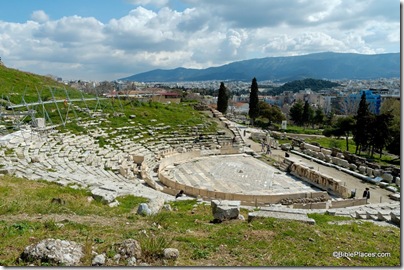I was invited this year to attend the Bible and Archaeology Fest in New Orleans. This was the 12th annual series of lectures sponsored by the Biblical Archaeology Society. While most professors and graduate students attend the annual professional meetings of SBL and ASOR, this series is targeted toward those with a high level of interest but who have less training. Many of the lecturers commented that they enjoy the conference so much because the attendees are so highly motivated. I certainly found that to be true, and I personally enjoyed the conference. The presenters were all first-rate. They were articulate, well prepared, and engaging. All of them illustrated their lectures with visual aids. I can recommend the series to you without hesitation or reservation. I didn’t agree with everything the lecturers said, but my thinking was never unprovoked. Hopefully some of that will come up in a short series I hope to post here.
I’ll start the series with the presentation on the 2009 excavations of Omrit, given by Co-Director, Dan Schowalter. I noted Omrit here recently when the archaeologists made public their theory that the Omrit temple, and not the one at Caesarea Philippi (Banias), should be equated with King Herod’s imperial temple.
In excavations since 1999, archaeologists have identified three successive temples at the site. The first, dubbed the “Early Shrine,” was built not earlier than 50 BC and probably went out of use not later than 20 BC. Schowalter suggested that the builders of Temple Two were unaware of the Early Shrine until they began construction. They thought the Early Shrine was a tomb and so they left unguentaria behind, but the excavators think they were incorrect in their identification.
Temple One is credited to King Herod, and the archaeologists believe this is the temple that Josephus mentions as being near Paneion (Caesarea Philippi; Ant. 15.10.3). Built in 20 BC, this temple was much more impressive in construction than the Early Shrine. For reconstruction diagrams, see this page at Macalester College’s website.
Temple Two was an expansion, built c. AD 80, which included a colonnade and staircase. The columns were about 30 feet (10 m) tall, and niches (for statues?) flanked the monumental staircase.
This temple may have been destroyed in the earthquake of AD 363.
In the future, archaeologists would love to discover the ancient name of the site. A Greek boundary inscription with the name of Emperor Diocletian (late 3rd century) was broken off and the city name was not preserved.
Survey work in January 2011 will benefit from last summer’s grass fire. The site is much larger than the temple area and includes an acropolis which is elevated above the temple site.
The government has proposed plans that would provide parking and an access path to the site.
Currently, it’s a challenge to find by car and impossible to arrive by bus.
Some of the impressive architectural pieces from the temple will be part of a new display in the Biblical and Archaeology Wing of the Israel Museum, slated to open next summer.
For a few photos of the temple, see this previous post.
UPDATE: I’ve been asked about the date and time of the next Bible and Archaeology Fest. If it
follows the pattern of previous years, it will be November 19-21, 2010 in Atlanta.




